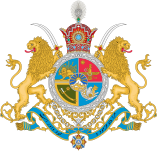Farahnaz Pahlavi
| Farahnaz Pahlavi | |
 Farahnaz Pahlavi 1980 | |
| Född | 12 mars 1963 |
|---|---|
| Nationalitet | Iranier |
| Medborgare i | Iran |
| Utbildad vid | Bennington College, Columbia University |
| Sysselsättning | Barnpsykolog |
| Befattning | |
| Prinsessa | |
| Föräldrar | Mohammad Reza Pahlavi och Farah Pahlavi |
| Släktingar | Shahnaz Pahlavi (syskon) Reza Pahlavi (syskon) |
| Utmärkelser | |
| Jubileumsmedaljen från firandet av 2500-årsdagen för grundandet av shah-dömet i Iran | |
| Heraldiskt vapen | |
 | |
| Redigera Wikidata | |
Farahnaz Pahlavi (persiska: فرحناز پهلوی), född 12 mars 1963 i Teheran, är en iransk prinsessa av Pahlavidynastin och den äldsta dottern till Mohammad Reza Pahlavi och Farah Pahlavi. Hon är syster med den iranske tronarvingen Reza Pahlavi.
Biografi
Farahnaz Pahlavi föddes i Niavaranpalatset i Teheran 1963. Hon fick sin grundutbildning vid Niavaranskolan i Teheran fram till den iranska revolutionen 1979. När familjen tvingades i landsflykt studerade hon vidare vid Ethel Walker School i Simsbury, Connecticut, USA, och Cairo American College i Kairo, Egypten. Från 1981 till 1982 gick hon på flickskolan Bennington College i Bennington, Vermont.[1] Hon tog en kandidatexamen i socionomi med inriktning på socialt arbete från Columbia University 1986 och en magisterexamen i barnpsykologi från samma universitet 1990. Hon lever (2021) i New York där hon arbetar som psykolog.
Före revolutionen var en sjö och en dammbyggnad, Farahnaz Pahlavi Dam, nordost om Teheran och ett sjukhus i Teheran, Farahnaz Pahlavi-sjukhuset, uppkallade efter henne.[2]
Referenser
- ^ Albin Krebs and Robert Mcg. Thomas (28 november 1981). ”Notes on People; A Daughter of Shah Auditing College Classes”. The New York Times: s. 39. https://www.nytimes.com/1981/11/28/nyregion/notes-on-people-a-daughter-of-shah-auditing-college-classes.html.
- ^ Farzaneh, Mateo Mohammad (2021-02-22). Iranian Women and Gender in the Iran-Iraq War. Syracuse University Press. doi:. ISBN 978-0-8156-5516-9. http://www.jstor.org/stable/10.2307/j.ctv16x2bhh. Läst 9 februari 2023
Media som används på denna webbplats
Flag of Iran. The tricolor flag was introduced in 1906, but after the Islamic Revolution of 1979 the Arabic words 'Allahu akbar' ('God is great'), written in the Kufic script of the Qur'an and repeated 22 times, were added to the red and green strips where they border the white central strip and in the middle is the emblem of Iran (which is a stylized Persian alphabet of the Arabic word Allah ("God")).
The official ISIRI standard (translation at FotW) gives two slightly different methods of construction for the flag: a compass-and-straightedge construction used for File:Flag of Iran (official).svg, and a "simplified" construction sheet with rational numbers used for this file.
Farahnaz Pahlavi
Imperial Coat of Arms of Iran under the Pahlavi Dynasty, used from 1925 to 1979. The shield is composed of the Lion and the Sun symbol in first quarter , in the second quarter the Faravahar representing Zoroastrianism, in the third quarter the curved blade of a Imam Ali "Zulfiqar" sword representing Shia Islam, and the Simurgh in the fourth quarter. Overall in the center is a circle depicting Mount Damavand with a rising sun, the symbol of the Pahlavi dynasty. The shield is crowned by the Pahlavi crown and surrounded by the chain of the Order of Pahlavi. Two lions rampant regardant, holding scimitars supports the coat of arms on either side. Under the whole device is the motto: "Mara dad farmud va Khod Davar Ast" ("Justice He bids me do, as He will judge me" or, alternatively, "He gave me power to command, and He is the judge"). Some of the colours were changed in 1971.



